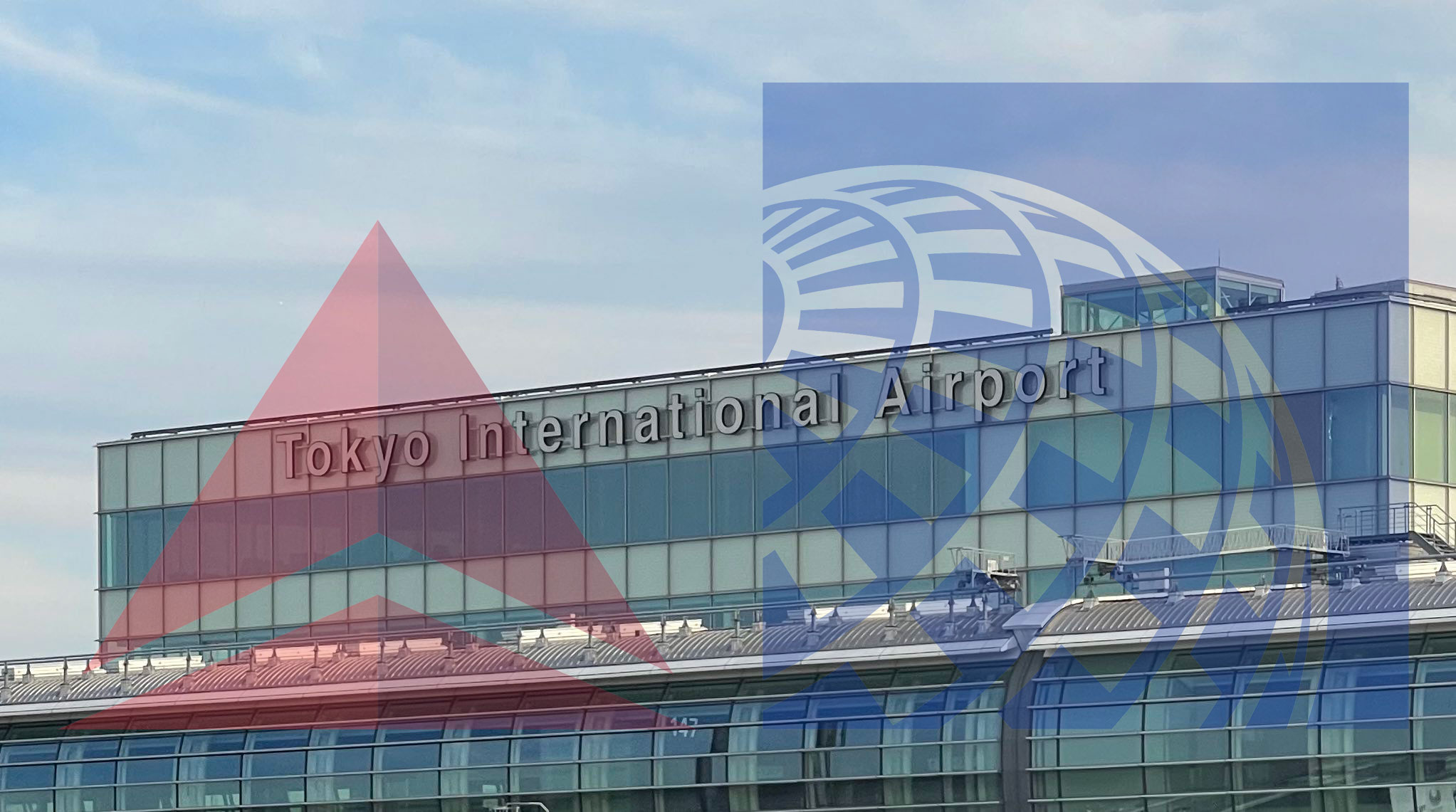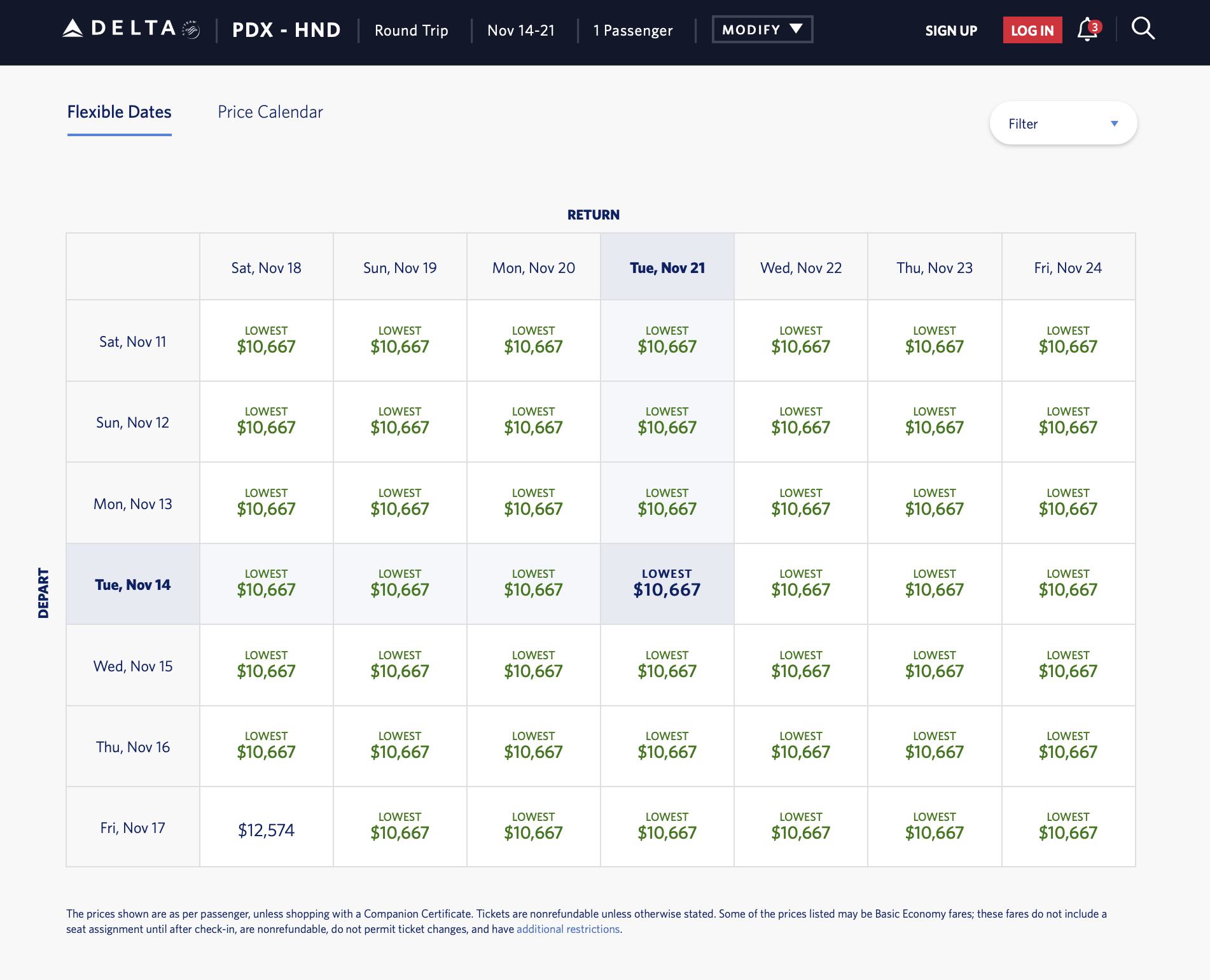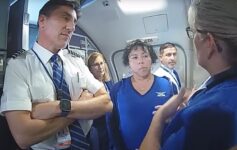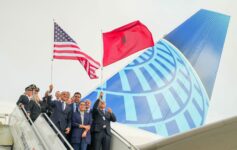
United Airlines is mounting an aggressive challenge to Delta Air Lines’ efforts to obtain more flexibility in the use of Tokyo Haneda slots assigned in 2019.
Delta Air Lines Wants More Flexibility To Use Tokyo Haneda Slots – American Airlines Agrees
In 2019, the US Department of Transportation (DOT) dispersed a number of new slots between the USA and Tokyo Haneda, assigning these slots based upon specific usage:
- American Airlines
- Dallas-Fort Worth (DFW)
- Los Angeles (LAX)
- Delta Air Lines
- Atlanta (ATL)
- Honolulu (HNL)
- Los Angeles (LAX)
- Minneapolis (MSP)
- Portland (PDX)
- Seattle (SEA)
- Hawaiian Airlines
- Honolulu (HNL)
- United Airlines
- Chicago (ORD)
- Los Angeles (LAX)
- Newark (EWR)
- San Francisco (SFO)
- Washington (IAD)
But since the pandemic, carriers have been granted a slot waiver, relieving them of their obligation to operate these flights on a “use or it lose it” basis. That waiver is set to sunset in October 2023.
Ahead of that sunset, Delta has asked DOT for more flexibility in the use of its assigned slots, specifically requesting that all US carriers to Haneda be able to use two slots on an ad hoc basis. Delta claims that demand remains depressed and this move will allow it and other carriers to more effectively match demand to Japan’s capital city.
Just as air carriers need flexibility to make market-based decisions on when and where to deploy their network and operational assets for purposes of preserving their limited-entry DOT-issued international route authorities, so too do they need flexibility to determine the optimal U.S. gateways for serving Haneda – a market that remains extraordinarily depressed relative to 2019 volumes…
Granting U.S.-Haneda slot holders the gateway flexibility described in this motion as part of a three-year pilot program will be pro-consumer, pro-competitive, and serve the public interest because it will enable U.S. carriers to respond more nimbly to the evolving demand environment in Asia following the COVID-19 pandemic.
American Airlines, which offers a very limited number of routes to Asia, is onboard with Delta’s proposal:
As a current U.S.-Haneda slot holder, American supports the requested relief. Enabling flexible, market-based decision-making for U.S.-Haneda service is warranted in the current demand environment. Gateway flexibility for up to two current slot pairs would create public benefits by allowing all participating carriers to adapt their networks to the evolving conditions.
But now United has come out swinging against the request by Delta.
United Airlines Strongly Opposes Slot Flexibility Request
In a hastily assembled phone call with reporters yesterday, United Chief Communications Officer Josh Earnest contended that Delta is deliberately raising prices on routes it wants to suspend in order to argue that demand is not present. United strongly oppose the request by Delta to give it more flexibility to use pre-assigned Haneda slots.
Earnest presented a “mystery” as to why Delta is charging over $10,000 round-trip for nonstop flights between Portland and Tokyo, set to resume in October after the slot waiver expires. Indeed, Delta is only selling full-Y (unrestricted) fares on the nonstop routes and they do price at more than $10,000 round-trip in economy class on every single day:


Adding a connection in Seattle drops the fare to $1629 round-trip.
Earnest contended:
“If Delta is not going to fly the routes they were awarded, they should say so, so that other airlines (including United) can compete for the opportunity to do so.”
In a regulatory filing opposing the move, United argues:
The Department should reject Delta’s latest self-serving scheme for an unprecedented, and untested “pilot program” for “limited” gateway flexibility at Tokyo Haneda just as the Department has rejected Delta’s and others’ prior requests for gateway flexibility, and should continue to use its own unbiased judgment in allocating rights based upon a full and complete assessment of public benefits.
Contrary to Delta’s contention, United contends that demand to Tokyo has experienced a strong rebound:
Despite the challenges of the COVID pandemic, the U.S.-Japan market is rebounding, and access to limited entry route rights should continue to be about consumers, communities, and shippers as it always has been, not about carriers’ financial performance. It is the Department that should be the ultimate arbiter of the best U.S. gateways to ensure maximum benefits of the Haneda slots – not Delta or American, who are appearing to prioritize their own profits over benefitting consumers.
Delta, however, insists its petition is well-reasoned, though did not address the abnormally high nonstop fares between PDX and HND.
“Delta stands by our well-reasoned petition to the Department and we look forward to a constructive dialogue to ensure Haneda access is consistent with Open Skies policy and benefits the U.S. traveling public.”
United wants to start nonstop service from Houston and Guam with Delta’s Tokyo Haneda slots.
My Take: Carriers Do Not Own Haneda Slots And Should Not Be Able To Self-Regulate Their Use
It’s clear that Delta’s lack of an airline partner in Japan makes service to Tokyo difficult. I do not doubt that the nonstop routes have not performed as well as hoped for.
But United makes the stronger argument here:
- Carriers do not own these 2019 Haneda slots: they were allocated based upon specific city pair uses as judged by DOT to most benefit consumers
- Delta obscures true demand to Japan by failing to distinguish between demand recovery originating in Japan versus in the United States
- It was has only been two weeks since Japan ended the last of its COVID-related travel restrictions for Japanese citizens: of course demand is still going to be weak, particularly originating in Japan
- The high fares on the Portland – Tokyo flight do appear to be a smoking gun: it is not convincing for Delta to claim there is no demand from Portland while offering fares so high that any reasonable person would not buy them.
Ultimately, carriers do not own these slots in a fungible way: the specific city pairs assigned were carefully considered by DOT to best benefit consumers. It may be that 2019 demand does not reflect 2023 demand and the slot awards should be revisited: but that should be done by DOT, not by the individual carrier. There should be no de facto chattel ownership of these slots.
CONCLUSION
United Airlines has come out swinging against a request by Delta to grant it more flexibility in the use of its Tokyo Haneda slots. Calling Delta’s move “self-serving” and “gaming the system,” United has asked DOT to deny Delta’s request, supported by American, to be able to freely use two Haneda slot pairs as it sees fit.
The issue now goes before DOT for consideration.




A very strong and convincing objection by United indeed.
I commented this on an earlier post today, but also worth noting United confirmed LAX-NRT is returning in October in this objection. No mention of HNL-NRT though so assume that is gone.
I’d be really surprised if the DOT sided with DL. I already felt that way last week when DL put in the request, and now I feel even stronger after UA’s objection.
Actually, HNL-NRT service is coming back on Oct. 29.
Actual facts differ from the statements many make here and I am here solely to present facts and truth.
– NW was the largest transpacific airline for years but its transpacific system DID NOT consistently make money. It lost substantial amounts of money for years.
– Delta inherited the NRT hub and tinkered for a few years but began cutting beyond NRT destinations because they weren’t profitable.
– United jumped in and expanded across the Pacific but became unprofitable while Delta became the only US airline that was consistently profitable flying the Pacific pre-covid.
– Japan, not any airline, made the decision that HND would be the Tokyo airport for all longhaul premium carrier (full service) flights while NRT would become a low cost carrier airport. Other countries have made similar airport access requirements. How many flights does United or American have from LGW or ORY?
– NRT Is not viable as a hub for much longer based on the same principle that applies at LHR and CDG – which are the premium airports for longhaul travel.
– AA and UA traded giving Delta more access to HND for the ability to launch JVs with Japanese carriers.
– DL tried but failed to operate select longhaul flights from HND and instead is developing its partnership with Korean as the connecting hub in NE Asia while HND will be all about local traffic. Even if AA and UA are carrying more traffic via NRT, their revenues per flight are far below what they or Delta carry to/from HND for local Tokyo passengers.
– Delta is still in the process of restructuring its transpacific network but has the most growth longhaul capacity of any US airline and already has the most efficient widebody fleet. An expected order for A350-1000s would give Delta a significant cost advantage that will last for more than a decade – and the A350 is the best plane for transpacific operations.
– American is ALSO supporting what Delta is asking for and it is very likely that the DOT will grant Delta’s request which will apply to ALL US carriers including Hawaiian which is ALSO not operating all of its allocated HND flights.
– it is almost certain that UA will also move some of its flights around – but the DOT and AA and DL will all note that UA/NH is the largest frequency holder to HND and has a vested interest in rejecting their opposition if it even materializes.
facts are facts as uncomfortable as they are for some people
What’s your point ? who cares about the airplanes that Delta might order? It’s not a done deal. And that’s nice and it does make sense for Delta to route its transfer traffic over Korea.
What does any of that have to do with Delta’s request? Or the FACT that Delta’s trying to charge $10K for PDX-HND? you’re trying to excuse away Delta’s inability to use their slots at HND. It’s not the end of the world that the cant or are having a tough time at it. Why’s that fact so hard for you to acknowledge?
Tim, most of the points you make here are irrelevant. Why bring up how big NW was in the Pacific? It doesn’t matter anymore because DL has fumbled it and now is a very small player in the TPAC market compared to UA. It also is ridiculous for you to claim that DL has the most long haul growth capacity. Did you know UA has up to 200 787s coming, of which a good amount are net new planes and not replacements. UA already has a much larger WB fleet than DL, and that will not change. And I know DL loyalists like you like to claim retiring the 777s was a great move, but in reality everyone knows that was a short sighted decision.
The fact of the matter is UA has become the dominant US long haul carrier in pretty much every region except Deep South America where they trail AA a little. Even in Europe, where DL used to have a big lead, UA is now the dominant carrier and will continue to build on that. And in the coming years are most of UA’s new planes come online, they will continue to bolster the domestic network, and within a few years UA will be beating DL in everything, both domestically and internationally.
We are finally starting to see what the potential of the United and Continental merger will look like under aggressive management that isn’t afraid of its competition looks like, and that looks like a very bright future for UA.
What is 10000-USD in SkyPesos? 100 trillion SkyPesos? Keep ¢limbing.
What a vexing post about vague decades old history that is non-sequitur to the discussion. Fascinatingly vexing indeed. The topic at hand is a simple one and delta’s lack of a response on pricing is telling.
United makes the beat and most logical case and if the Government stands by precedent and rule United should win.
Tim,
Clearly you have no experience with or understanding of DOT route allocation proceedings as not a single one of the “facts” you posit bear any relevance to the DOT’s consideration of authorities. For one thing, historical network and route profitability are not among the public interest factors that are evaluated as a matter of law.
Further, what do you mean by Delta “has the most growth longhaul capacity of any US airline”? What exactly is “growth longhaul capacity”? That’s not a metric I’m familiar with, as someone who actually does this for a living and does not troll message boards and blogs to cheerlead for Delta.
I don’t expect the DOT to grant Delta’s “pilot program” application wholesale (nor will it for UA’s opposition), as it has no legal precedent and is clearly a self-serving attempt by Delta to circumvent the terms of the negotiated US-Japan bilateral. A dormancy proceeding, and even perhaps a temporary award following same to another airline would likely be the DOT’s decision.
I normally expect to be confused by Tim’s posts, but this is like trying to decipher a plate of spaghetti that has been thrown up against a wall.
UA is profitable to Asia.
UA has hubs much better suited to long haul flying, especially when the high-yielding traffic wants nonstop flights and not a connection in MSP or SEA.
UA is double daily to SIN, in addition to service to KIX, TPE, HKG, all cities closed by DL. DL is not superior to UA in Asia.
UA already has close to 100 787s in service, with potentially 200 more coming. Not sure how an unplaced DL order would change things.
Tim constantly says the A350-1000s have the lowest costs. Then why doesn’t DL fly them to MCO, LAS, DFW, or OMA? The answer is that you need to fill the planes with high-yielding traffic. Otherwise you’re just flying a large plane around with low fares.
The most long haul growth? I don’t even know what that means, but UA’s growth has vaulted them to the largest carrier to Europe and widened their lead to Asia, including being the biggest carrier to Australia, even bigger than QF. Are you saying DL is going to become number one in all those regions?
Why is it so hard to admit that DL’s strength is not in Japan. They will flow traffic over ICN with KE. Nothing wrong with that. If you could just admit an area DL isn’t succeeding, you’d gain so much credibility.
Brilliant response Tim, the other commenters just don’t get it. But the bigger idiots are those who omitted your relevant points in Delta’s filing to the DOT.
The truth hurts. Delta was the number one carrier both in profitability and traffic to Asia and Latin America in 2022. Also, don’t forget that ICN is the largest and most profitable transpacific market. Japan is easily served from Korea as there are no SK-Japan bilateral restrictions involving 3rd country carriers. Same for China, open market crawling with lots of growth opportunity. Routing circuity with ICN is merely theoretical. It’s also impossible to run two hubs in a city successfully which is why a two hub one city concept doesn’t exist outside Tokyo. And the A350-1000 is a total CASM killer which is why Delta and it’s partners such as KE, AF-KLM, AM, and LA have the largest orders and deliveries of the -1000 on aggregate of any partnership. Don’t forget the refinery benefit that gives Delta an advantage with its transpacific routes in the northeast.
palindrome??
Mitt–ttim
Nud–dun
Well it didn’t take long for ole’ Timmy to show up. Mr. Dunn, what you’ve just said is one of the most insanely idiotic things I have ever heard. At no point in your rambling, incoherent response were you even close to anything that could be considered a rational thought. Everyone in this room is now dumber for having listened to it. I award you no points, and may God have mercy on your soul.
You can book that PDX-HND in Delta One for 495,000 SkyMiles. There are certainly worse ways to use them.
That’s one way, right? For SkyPesos standards that is actually isn’t even that bad of a redemption. I’ve seen much higher on shorter flights to Europe.
I was booking a trip to Auckland last week, and of course I am going to fly UA, but I wanted to check just to see others are offering, and Delta is offering LAX-AKL at 440,000 SkyPesos each way! And that doesn’t even get me direct aisle access, I have to step over my neighbor to leave my window seat.
But at least you’d have a premium lounge to go to at LAX… Oh wait!
@Jerry Haha I’d have to wait in the huge line to get into the standard club, with all the Platinum card holders who want their free chips and sandwiches, what a joke after having given them almost a million SkyPesos!
I ended up booking UA’s inaugural LAX-AKL and put in a PlusPoint upgrade request – wish me luck!
@Jan how am I going to get enough SkyPesos to even buy G fare? What is cheap in SkyPesos? I somehow have 37k SkyPesos in my account, which I have no idea where they’ve come from, I’ve only taken like 3 cheap flights with DL between DEN and LAX since creating that account 3 years ago. I have my Lyft linked to it and spend a good amount per month on Lyft- but still crazy I have that much. But the sad part is that probably isn’t even enough for a domestic coach ticket.
@Jared Houser G fare is the least expensive cash PS fare (TATL it’s about $900-1300 on the low end). I agree that pure Skypesos redemption is usually garbo but that upgrade to D1 is one of the most effective ways to use said pesos.
@Jan I didn’t think of that, that’s interesting and definitely a good idea. How does it work though, it isn’t an instant upgrade is it? Assuming it puts you on a waitlist similar to how UA does it? The issue is DL’s WB fleet has tiny business class cabins, so doubt many upgrades ever clear.
@Jared Houser the fun part is you have to call DL to manually upgrade you. IIRC The upgrade pulls from the OY award fare, so it could be instant, or could have some waitlist if OY inventory isn’t open. And of course, you run the risk of an equipment change, considering DL’s inconsistent D1 product, and your A359 suites could turn into LATAM A359 or dated 763.
Smart SkyPesos users will buy a cheap G fare and upgrade to D1 for 40k Skypesos
The challenge of course is finding a cheap G fare (plenty TATL, a challenge in TPAC so far)
@Jan I’d send you my 37k SkyPesos if there was a way to transfer them
One factor I didn’t see mentioned (and I could have missed) is that the Japanese airlines, JAL and ANA, have the flexibility to move their slots. Both of those airlines have immunized joint ventures with U.S. carriers (American in the case of JAL, and United in the case of ANA). Delta doesn’t have the same level of flexibility those two joint ventures enjoy. That’s why I think Delta should be allowed to move some of its authorities.
Why didn’t DL ask for a HND flight from JFK in the first place? Even back in 2019, NYC was a large market for them with a lot of business demand.
PDX doesn’t seem like it had much hope to succeed, essentially being a long haul flight between two spokes.
Seems like that would be similar to UA flying PDX-AMS or AA flying PDX-CDG.
I’ve wondered the same. DL did operate JFK-NRT in the past, with the 747-400 (post merger) but then dropped the route. Guessing DL knows its product is inferior to NH and JL and given the muted demand between the US and Japan at the moment, it doesn’t want to re-enter the market or is the issue the frames? The A330-900 has the legs, no for JFK-HND, otherwise DL’s only other plane for this route is the A350. The A333s and A332s can’t make JFK-HND, right?
I’m waiting for Delta to exit flying across the Pacific. I was a long time Northwest flyer before Northwest disappeared and Delta took over. My mileage was used on a Korean Airlines flight to Bangkok and back. When I tried to get a Delta flight, I would have to fly from LAX to MSP before going across the Pacific for the best rates so I started flying on EVA which had shorter and faster flights, fewer connections, good prices, good food and great flight attendants. I have never seen Delta commit to a price competitive, good schedule across the Pacific for a coach class flyer such as myself. Northwest had a great mileage program that had me taking extra flights just to stack extra miles to get the next award. Because of that, I was willing to pay higher prices when I bought their tickets.